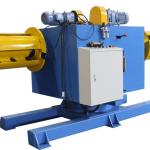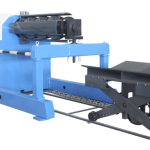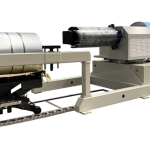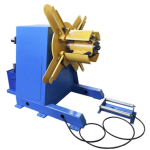Q4: How is the phenomenon of end flare generated in roll forming, particularly in profiles like C-purlins, and what engineering techniques are used to minimize this defect?
End flare (also known as “fishtailing” or “end sweep”) is a dimensional defect where the cross-section of the roll-formed profile deviates from the target profile at the leading and trailing ends of the finished piece. This phenomenon is a direct consequence of the complex stress and strain history required for forming the profile.
1. The Physics of End Flare Generation
End flare is a manifestation of **longitudinal residual stress** release, particularly elastic recovery at the unconstrained ends of the strip.
A. Longitudinal Stress Build-up
During the roll forming process, the metal strip is subjected to both **transverse** (bending) and **longitudinal** (along the strip’s length) stresses.
- Transverse Stress (Bending): Necessary to achieve the profile’s shape.
- Longitudinal Stress: This is an undesirable, unavoidable side effect. As the strip bends in the rolls, the total length of the strip must remain the same through the machine. However, the inner flange portions (smaller bend radii) try to compress longitudinally, while the outer web portions (larger effective radii) try to stretch. This creates a non-uniform distribution of longitudinal strain and stress across the width of the strip.
B. The Unconstrained End Effect
- Intermediate Section: In the continuous section of the strip (far from the ends), the metal is laterally constrained by the rolls and longitudinally constrained by the strip section immediately following it (which is already formed and rigid). The built-in residual stresses are held in equilibrium.
- Leading/Trailing Ends: When the end of the strip enters or exits the last set of forming rolls, the longitudinal constraint is suddenly removed. The stored elastic strain energy, which was previously balanced by the continuous strip, is released at the unconstrained end.
- Cross-Sectional Deviation: For an open profile like a C-purlin, the high-stress areas (the open flanges) snap inward or outward (flaring) to relieve the longitudinal tension or compression.
- Leading End (Front Flare): Typically “flares in” (flanges pull toward the web center) due to the release of built-up compressive stresses.
- Trailing End (Tail Flare): Typically “flares out” (flanges move away from the web center) due to the release of built-up tensile stresses.
2. Engineering Techniques for Flare Minimization
Controlling end flare requires balancing the stress distribution across the profile width, particularly in the later forming passes.
A. Optimization of the Flower Pattern (Gradual Forming)
The most critical method is to ensure that the bending is distributed as gradually and evenly as possible across the number of stands.
- Strain Control: By minimizing the amount of bending per pass, the accumulation of non-uniform longitudinal strain is reduced. The roll designer must ensure that the strain rate is smooth and continuous.
- High Pass Count: Using more roll stands (higher $N$) for complex profiles is often the most effective, albeit more costly, way to reduce flare, as it smooths the stress increments.
B. Utilizing Side Rolls (Lateral Constraint)
Side rolls (often simple bearings or powered rollers) are installed between the final stands, sometimes after the last stand, to apply precise lateral pressure to the flanges.
- Controlled Inward Pressure: These rolls push the flanges slightly inward at the exit end of the line. This induces a small, controlled amount of plastic deformation opposite to the direction of the expected flare, preemptively compensating for the stress release.
C. Roller Taper and Gap Setting
Fine-tuning the geometry and vertical gap of the final rolls is crucial:
- Roll Gap Adjustment: By slightly closing the roll gap below the material thickness in the last one or two stands, a mild amount of longitudinal stretching/ironing can be induced. This helps to reduce the compressive stress component that causes inward flare.
- Roll Taper (Axial Displacement): Sometimes, the rolls are minutely tilted or displaced axially to apply non-uniform pressure across the width, counteracting the stress imbalance.
D. End Tapering (Machine Control)
Advanced, computer-controlled roll formers (Dynamic Roll Forming) use the cut-off signal to implement real-time machine adjustments:
- Hydraulic/Servo Control: Just before the cut-off, the machine may slightly adjust the roll gaps or side roll positions to intentionally under-form the end of the profile in a manner that compensates for the known inward/outward snap.
In essence, end flare is a classic problem of boundary conditions and residual stress in continuous manufacturing. Its minimization requires precise control over the strain history (gradual deformation) and the strategic application of lateral constraint (side rolls) to stabilize the profile when the longitudinal stiffness constraint is lost at the end of the strip.









